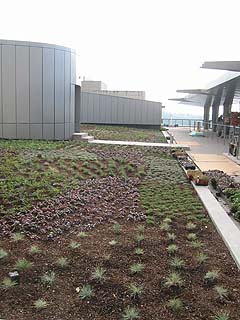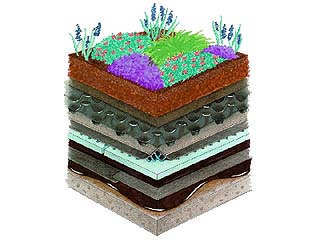|
Subscribe / Renew |
|
|
Contact Us |
|
| ► Subscribe to our Free Weekly Newsletter | |
| home | Welcome, sign in or click here to subscribe. | login |
Construction
| |
 |
October 31, 2002
Sustainability comes with a view
SvR

Courtesy of SvR The Justice Center’s 12th-floor plaza transforms what would have been a conventional flat roof into a living system that will absorb the rain and provide a rooftop oasis. |
Earlier this month, Seattle’s mayor was caught with dirt on his hands.
Mayor Greg Nickels led the ceremonial planting of the green roof at the new Justice Center by planting the first plant.
“The Justice Center is an excellent example of a sustainable building,” Nickels said, “and the rooftop is its crowning glory.”
The green roof is on the Justice Center’s 12th-floor plaza. It transforms what would have been a conventional flat roof into a high-profile oasis that provides a contemplative viewing garden for city staff and visitors.
The carefully engineered green roof is not only beautiful, it is also functional. The green roof will attenuate stormwater runoff, reduce energy costs and moderate the urban island effect.
What’s a green roof?
A green roof, also known as an eco-roof or a living roof, is an engineered, vegetated roofing system composed of reinforced waterproofing layers, a soil support system and plants.
There are two types of green roof systems: extensive and intensive. An extensive system, which was chosen for this installation, is characterized by shallow soils typically 3 to 6 inches deep. The weight of an extensive system with saturated soils is not much heavier than that of conventional rooftop ballast applications, making additional structural support systems unnecessary.
An intensive green roof differs from an extensive green roof primarily in soil depth. Intensive green roof soils are deeper than 6 inches, allowing for larger plants. The additional soil produces a heavier roof load, which often requires additional structural support.
Design concept
SvR’s landscape concept for the Justice Center green roof builds upon the water theme central to the street-level Civic Center plaza.
Guided by an image of sunlight reflected in a shallow streambed, the green-roof plant layout creates naturalistic, flowing patterns throughout the garden area, with groundcover plants of varying textures and shades of blue, gray and light green. Throughout the planting, sheep fescue provides a unifying silvery-gray element representing the ripples found in a slow-moving, shallow stream.
With sustainability being the top design criterion, an irrigation system was rejected for the green roof. Due to the harsh rooftop environment, including wind, heat and lack of permanent irrigation, the plantings include a wide range of heat-tolerant and drought-resistant groundcovers able to thrive in the shallow skim of soil. Hose bibs are located nearby to aid in establishing the plants for the first few years.
The planting design and associated drainage facilities were developed as a low-impact system that controls and reduces stormwater runoff. At the Justice Center, rain that falls on the green roof is initially absorbed by the soil and used by the plants mimicking natural predeveloped conditions and lessening the impact on downstream drainage facilities. Excess rain drains to a collection system, and ultimately to a cistern to be harvested for reuse at the plaza level.
Benefits
The green roof’s soil layer has a sponge-like quality that can capture between 50 percent and 70 percent of the site’s stormwater runoff, providing relief to the city’s downstream combined stormwater/sewer systems. The planting can also slow the rate of runoff because the roots absorb water as part of the plants’ natural transpiration process. Evaporation also reduces the runoff.
Energy savings can be realized because the soil layer provides thermal insulation, reducing the solar heat gain common to conventional roofs. The insulating effect of the soil helps moderate interior building temperature extremes by slowing the heat transfer to the structure in the summer and reducing heat loss in the winter. This lowers the cost of heating and cooling.
Life-cycle analysis suggests the waterproofing for a green roof will last longer than a conventional roof. By protecting the waterproofing from ultraviolet degradation, mechanical puncture and temperature extremes, green roofs are less susceptible to heat damage and cracking.
Green roof technology

Courtesy of SvR The green roof is made up of a multilayered waterproofing membrane that’s integrated with a soil support system. The egg carton-shaped water retention liner helps retain moisture in the shallow soil between rainfalls. |
The Justice Center green roof consists of a multilayered waterproofing membrane integrated with a soil support system. The first layer in the system is the waterproofing component. Installed over a prepared roof surface, it is a flexible monolithic membrane composed of refined asphalts and synthetic rubbers.
An extra layer of fabric reinforcement is included between two membrane applications. Additional layers over the waterproofing form the integrated soil support system, which comprises the root barrier, insulation, water-retention liner, filter fabric and a lightweight planting soil.
A significant component of the soil support system is the egg carton-shaped water retention liner that helps to retain moisture between rainfalls. The shallow cups hold water and alleviate some of the harsh conditions of the rooftop environment, which can quickly dry because of the shallow soil profile.
Rainwater not retained by the soil or water retention liner flows through holes in the peaks of the liner cups, eventually making its way into subsoil runnels. The water then combines with unlandscaped roof area runoff in rainwater leaders that lead to a water-storage facility at street level. The captured rainwater is then reused to irrigate landscaping at the base of the building.
Future of green roofs
Green-roof installation has become an attractive option in cities throughout the U.S. and Canada. Because a green roof can mitigate the environmental impacts associated with development, a number of local agencies, including the city of Seattle, are looking at building incentives to reward developments that integrate sustainable practices such as green roofs.
The Justice Center and its new green roof are progressive examples of the city of Seattle’s commitment to protect, conserve and enhance our region’s natural resources. It also stands as a model for other developments that seek to incorporate sustainable, low-impact design solutions into their projects.
Through careful consideration and bold risk-taking, these greening strategies may become a common feature for future projects. Imagine the collective benefits as more green roofs begin to rise in our community.
Robin Laughlin is a landscape architect and Paul Dedyo is a civil engineer and associate with SvR. The firm is the civil engineer for the Seattle Justice Center, Seattle City Hall, Civic Center Plaza and the landscape architect for the Justice Center’s green roof.
Other Stories:
- A model for sustainable design
- Architectural odd couple is bound by public spirit
- Plaza helps unify civic campus
- Engineers had their fill of this site
- Justice Center art reflects social themes


